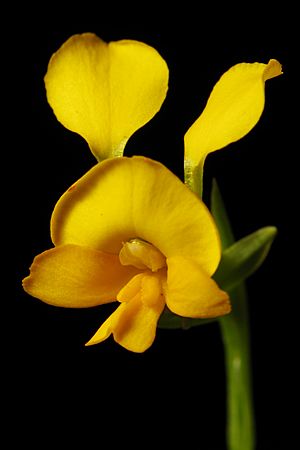Buttercup doubletail facts for kids
Quick facts for kids Buttercup doubletail |
|
|---|---|
 |
|
| Conservation status | |
| Scientific classification | |
| Genus: |
Diuris
|
| Species: |
aequalis
|
| Synonyms | |
The Diuris aequalis, also known as the buttercup doubletail, is a special type of orchid. It grows only in New South Wales, Australia. This orchid has two long, rolled leaves and beautiful golden-yellow to orange flowers. It is currently listed as "vulnerable," which means it needs protection to survive.
Contents
What it Looks Like
The buttercup doubletail is a plant that grows from a tuber, like a small potato. It is a perennial plant, meaning it lives for more than two years. It usually grows to be about 20 to 45 centimeters (8 to 18 inches) tall.
This orchid has two long, thin leaves that grow from its base. Each leaf is about 10 to 20 centimeters (4 to 8 inches) long and 3 to 4 millimeters (0.12 to 0.16 inches) wide. The leaves are rolled up, so their sides face each other.
The plant produces two to five golden-yellow to orange flowers. These flowers are arranged on a stem called a raceme. Each flower is about 25 millimeters (1 inch) wide and usually does not have spots.
The top part of the flower, called the dorsal sepal, is broadly egg-shaped or almost round. It is about 7 to 10 millimeters (0.28 to 0.39 inches) long. The side sepals are long and thin, about 8 to 13 millimeters (0.31 to 0.51 inches) long. They are shaped like a sickle and are green.
The petals stand upright and look like ears above the flower. They are about 6 to 10 millimeters (0.24 to 0.39 inches) long. The labellum (or "lip") of the flower is about 5 to 9 millimeters (0.20 to 0.35 inches) long. It has three parts, with ridges in the middle.
Buttercup doubletail orchids bloom between October and December. After flowering, their leaves die back. New leaves grow before the next flowering season.
How it Got its Name
The Diuris aequalis was first officially described in 1876. This was done by Robert D. FitzGerald. He used notes from an earlier description by Ferdinand von Mueller. The description was published in FitzGerald's book, Australian Orchids.
The second part of its scientific name, aequalis, comes from a Latin word. It means "like," "same," or "uniform."
Where it Lives
The buttercup doubletail orchid grows in the ranges and tablelands of New South Wales. You can find it between Braidwood and the Kanangra-Boyd National Park. It prefers to grow in forests and open woodlands. These areas usually have grassy ground cover and are often on gentle slopes.
Protecting the Orchid
There are only about 200 known buttercup doubletail plants left. Most of these plants are found along roadsides or on farmland. Because there are so few, this orchid is listed as "Vulnerable" (VU). This listing is under the Australian Government's Environment Protection and Biodiversity Conservation Act 1999 (EPBC Act).
The main dangers to this orchid include:
- Land clearing for farming or building.
- Animals eating the plants (grazing).
- Work done on roads, like mowing or digging.
- People illegally dumping rubbish.
In 2015, the buttercup doubletail was one of the plants highlighted in the "Save a Species Walk." This event aimed to raise awareness and help protect endangered plants.
Images for kids



